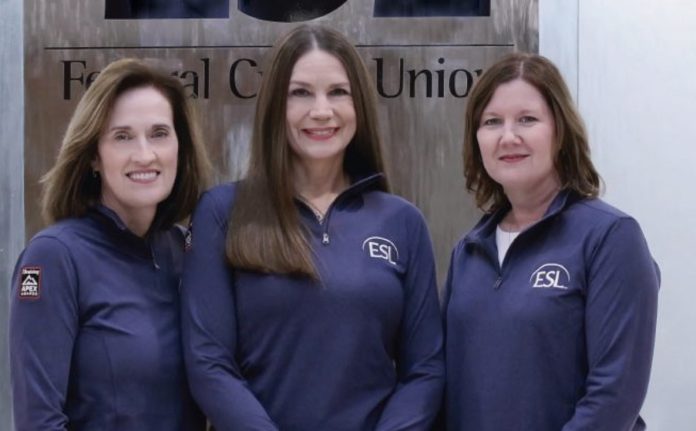
As a financial services company, ESL Federal Credit Union knows all about the importance of investment—particularly investment in employee training and development. In fact, ESL significantly increased its training budget in 2025 in order to continue providing best-in-class training and development opportunities to its growing employee population (143 new hires last year), according to ESL Vice President/Director of Organizational Development & Culture Julie Ahrens.
That investment has paid off, earning ESL not only the top spot on the 2025 Training APEX Awards list, but also making it eligible for induction into the Training Hall of Fame in 2026 after four Top 10 rankings in a row.
“ESL consistently evaluates resources, both financial and people,” Ahrens notes. That led to 2025 investments in new hire frontline training, leadership development coaching, training room infrastructure, system migration training, and an ongoing business transformation initiative.
A GOOD INVESTMENT
ESL’s largest training investment last year was in new hire frontline training. “Ranging between two and four weeks, based on role, this comprehensive curriculum is of paramount importance in cultivating a competent and confident employee population,” notes Executive Vice President of Human Resources & Community Impact Maureen Wolfe. “In 2025, 73 percent of all positions were filled internally, most commonly with staff from ESL’s branches and contact center.”
Where it makes sense, employees may have a hybrid schedule once their onboarding period ends. Currently, approximately 60 percent of ESL’s workforce can work in a hybrid arrangement. With ESL employees overwhelmingly indicating that they enjoy a hybrid work arrangement, Ahrens says, the company’s hybrid workplace model exposed a need to include learners from multiple locations in instructor-led classes, while ensuring a positive learning experience for all. To meet this need, ESL invested in training room infrastructure last year. Every training room was equipped with high-definition cameras and a state-of-the-art sound system. Used in conjunction with Microsoft Teams, the cameras, microphones, and speakers permit remote workers to see, hear, and participate in class along with those physically present. “The facilitator can manipulate the cameras to provide specific views of the classroom, including facing the facilitator, facing the screen, or panoramic classroom view,” says Yvette Charleton, ESL’s manager of Learning & Development (L&D). “Monitors on the wall provide a physical ‘presence’ for the remote participant, so onsite participants can more easily engage with those participating remotely.”
TRAINING CHALLENGES
One of ESL’s largest training challenges in 2023/2024 was an unexpected, but necessary, system migration for its Business Internet Banking administrative platform. “Among key changes was the user interface, used by myriad departments, from frontline to back office,” Ahrens says. “The organizational challenge was to complete the migration within a three-month timeframe. The challenge for Learning & Development was to train all users concurrent with the migration.”
With a need for expediency, L&D utilized Agile methodology for this fast-paced corporate project. The platform was migrated in phases as business decisions were finalized. Users had to learn their new interface in phases, based on role. “We built a robust series of online simulations, a unique set for each business unit,” Charleton says. “Employees completed them at the moment of need and could repeat them at any time.”

In addition to realistic simulations, each set included a printable Visual Reference Guide, keeping common functionality at the user’s fingertips. To augment the self-paced learning, L&D hosted facilitated learning labs. “Select employees from the operations help desk received all modules, providing comprehensive training that enabled them to become platform experts in support of all users,” Charleton notes.
Another major and ongoing challenge relates to the launch of ESL’s business transformation initiative. “The success of this enterprise-wide project depends on the ability of all employees to shift their mindsets to working in an agile environment,” Ahrens says. “Whereas employees are used to an environment in which tasks and decisions are weeks and months in the making, and the mechanics of how they do their work are long-standing, business transformation requires flexibility and comfort with rapid change.”
Learning & Development started by bringing in consultants who are experts in change management to teach managers the skills necessary to lead their teams through what will be a years-long project. “To augment this training, L&D created a suite of change management support tools for managers, to assist them in guiding their teams through the process,” Charleton explains. “Next, we had to teach the tenants of Agile methodology. L&D developed a package of self-paced training and support tools focused on Agile methodology. A dedicated business transformation site was built on our corporate intranet, and all change management and Agile resources are housed there for easy access.”
Rather than bring employees onsite for classroom training on each new element, employees will receive foundational knowledge, using a flipped classroom format, in small groups. Employees will “go live” in the new system as soon as they complete this brief training, with the support of designated members of ESL’s systems team and operations help desk. As part of the project team, L&D will create additional training materials and performance support resources as additional system features and functionality are released. Ahrens says ESL’s Market Intelligence team will assist in collecting feedback from live users and communicate the information back to L&D so any learning gaps can be addressed immediately.
DEVELOPING EMERGING LEADERS
Ahrens says ESL’s Emerging Leader curriculum was the company’s most effective training program in the last year. “It is built upon clearly defined leadership competencies, and all learning activities are tied to those competencies,” she says.“Emerging Leader is for managers who are newly promoted, or managers who are new to ESL, and focuses on creating and strengthening the basic behaviors required for leadership at ESL.”
Participants commit to eight hours per month for a three-month period, engaging in activities to improve their skill in listening, tolerating uncomfortable situations, encouraging and managing different points of view, creating and managing clear agreements and actions, and appreciating effort and results.
After several classroom sessions, participants gather with a group of the company’s senior leaders, including ESL’s president and CEO, to have a candid discussion about leadership, career paths, lessons learned along the way to senior leadership, and insights into the skills and behaviors that make leaders successful.
Ahrens says this results in a sharpened ability to translate ESL core values and leadership competencies into behaviors for effective leadership, thereby supporting ESL’s business goal of 90 percent of employees agreeing they are equipped to be successful in the ESL operating environment.
A combination of Kirkpatrick Level 3 surveys, manager interviews, and direct observations indicate an 86 percent increase in leadership competency usage among graduates. And in 2024, ESL surpassed the 90 percent goal with 91.26 percent of employees demonstrating they are prepared to be successful. “The overall percentage of promotions from within is at 73 percent, while that number is 93 percent for leadership positions,” Wolfe says.
COACHING IS KEY
Coaching is a key part of L&D at ESL and takes many forms, including relationship-building, career, and executive coaching. The most broadly applied form of coaching is formal observation coaching, Charleton says. “All managers of staff who speak directly with external customers are required to observe and coach their employees a minimum of two times per month, for a minimum of four customer interactions.”
The Observation Coaching workshop is a half-day of activity that includes:
- A deep dive into the process of observation coaching
- Linkage to policy
- Participant teach-back of the observation coaching procedure
- Role-play practice in conducting formal observations and facilitating coaching conversations
- Scenario-based group work during which managers reach consensus regarding challenging coaching dilemmas
- An objection clinic, during which managers collaborate on ways to address resistant employees and share tips on overcoming their own reservations
To reinforce the learning, L&D created a self- paced, online module available in ESL’s learning management system (LMS), and sponsors monthly coaching Webinars that provide managers the opportunity to share best practices and try new techniques in a safe environment. “The observation coaching process and companion resources support both our Employee Experience and our Customer Experience strategic priorities,” Ahrens says. “Success in these strategic priorities is measured by pulse surveys and net promoter score (NPS), with a target range between 59.2 and 65.4 percent.”
Some 142 managers and supervisors have been trained in Observation Coaching. Managers report that 97 percent of employees who are coached have improved service behaviors as a result, as indicated by movement from level I to level II, or from level II to proficiency status. “This behavior change translates into Kirkpatrick Level 4 results,” Ahrens says, “leading to our current NPS of 84.3 percent.”
In late 2023, ESL introduced what Ahrens calls “its greatest coaching innovation”: an electronic playbook with an artificial intelligence (AI) coaching assistant. “This is a closed system AI platform specific for coaching (all information stays within the ESL network), which allows managers to search the playbook for specific coaching themes and find resources to guide them through a coaching conversation. Embedded tools allow managers to track their progress against stated coaching goals,” Ahrens explains. “Most exciting is the coaching Genie, an AI-powered, virtual coach-the-coach tool. Managers simply click the Genie icon to access the assistant and type their coaching questions. Genie then guides them to the specific section of the playbook that will address the need.”
“It’s been interesting to witness how learner needs have changed over the years, and to consistently work to adapt to those changes,” Charleton says. “Factors such as a multigenerational workforce, the pandemic, and technological capabilities have prompted us to continually evaluate learner expectations: when they prefer to learn, their preferred modality, and the frequency with which they’d like to engage with learning opportunities.”
Adds Ahrens, “A strong learning and development program is anchored with your tried-and-true best practices, and enhanced by being open to new innovations, techniques, and technologies. It’s essential to find that balance and to have the courage to make the best decision for your learners and your organization.”




